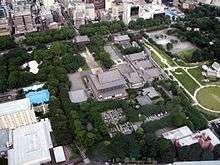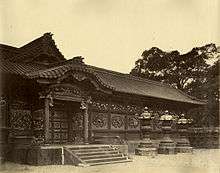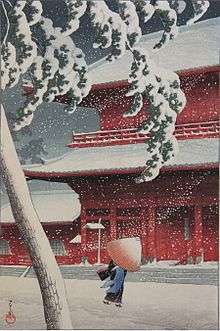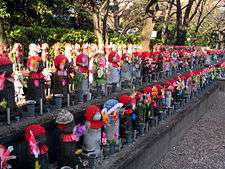Zōjō-ji






San'en-zan Zōjō-ji (三縁山増上寺 San'en-zan Zōjō-ji) is a Buddhist temple in the Shiba neighborhood of Minato, Tokyo, Japan. It is the Great Main Temple of the Chinzei branch of Jōdo-shū Buddhism. The main image is of Amida Buddha. The founder of Zōjō-ji was Yūyo Shōsō (酉誉聖聡).
History
Shūei (宗叡, 809-884), a disciple of Kūkai, founded a temple named Kōmyō-ji (光明寺) at Kaizuka (貝塚, present-day Kōjimachi in Chiyoda, Tokyo); it is said to be the forerunner of Zōjō-ji. Centuries later, in 1393 during the Muromachi period, at the time of Yūyo Shōsō, the temple converted from the Shingon to the Jōdo school. Shōsō is thus the founder of the present-day temple.
Together with Kan'ei-ji, during the Edo period Zōjō-ji was the Tokugawa's family temple. Tokugawa Ieyasu had the temple moved, first to Hibiya, then in 1590, at the time of expansion of Edo Castle, to its present location.
With the fall of the Tokugawa shogunate, the grounds took on the character of a public park. The temple was badly damaged in World War II, but still retains the air of a major temple.
The red Daimon (大門 "Great Gate") is the main entrance of Zōjō-ji. It was originally made out of wood, but burnt down during the Second World War. The present gate is made of concrete. The gate was also depicted multiple times in the art work of the Shin hanga artist Kawase Hasui during the 1920s and 30's.
Buildings
- Sangedatsu Gate (三解脱門 Sangedatsu Mon), 1622, Important Cultural Property: The temple's only original structure to survive the Second World War. "San" (三) means "three", and "Gedatsu" (解脱) means "Moksha". If someone passes through the gate, he can free himself from three passions (貪 Ton; "greed", 瞋 Shin; "hatred", 癡 Chi; "foolishness").
- Great Hall, 1974
Tokugawa mausolea
Six of the 15 Tokugawa shoguns are buried at Zōjō-ji. The Taitoku-in Mausoleum of Hidetada (and the monument to his wife Sūgen'in), Ienobu, and Ietsugu had been designated National Treasures of Japan, but were burned in World War II. At present, parts of two of their graves have the distinction of being Important Cultural Properties of Japan. Additional graves are located in the cemetery behind the Great Hall. Parts of the former grounds of the temple are now occupied by a golf practice range and a hotel.
Unborn Children Garden
In one particular garden at the cemetery, rows of stone statues of children represent unborn children, including miscarried, aborted, and stillborn children. Parents can choose a statue in the garden and decorate it with small clothing and toys. Usually the statues are accompanied by a small gift for Jizō, the guardian of unborn children, to ensure that they are brought to the afterlife. Occasionally stones are piled by the statue; this is meant to ease the journey to the afterlife.
See also
- For an explanation of terms concerning Japanese Buddhism, Japanese Buddhist art, and Japanese Buddhist temple architecture, see the Glossary of Japanese Buddhism.
External links
![]() Media related to Zōjō-ji at Wikimedia Commons
Media related to Zōjō-ji at Wikimedia Commons
Coordinates: 35°39′27″N 139°44′54″E / 35.657479°N 139.748376°E